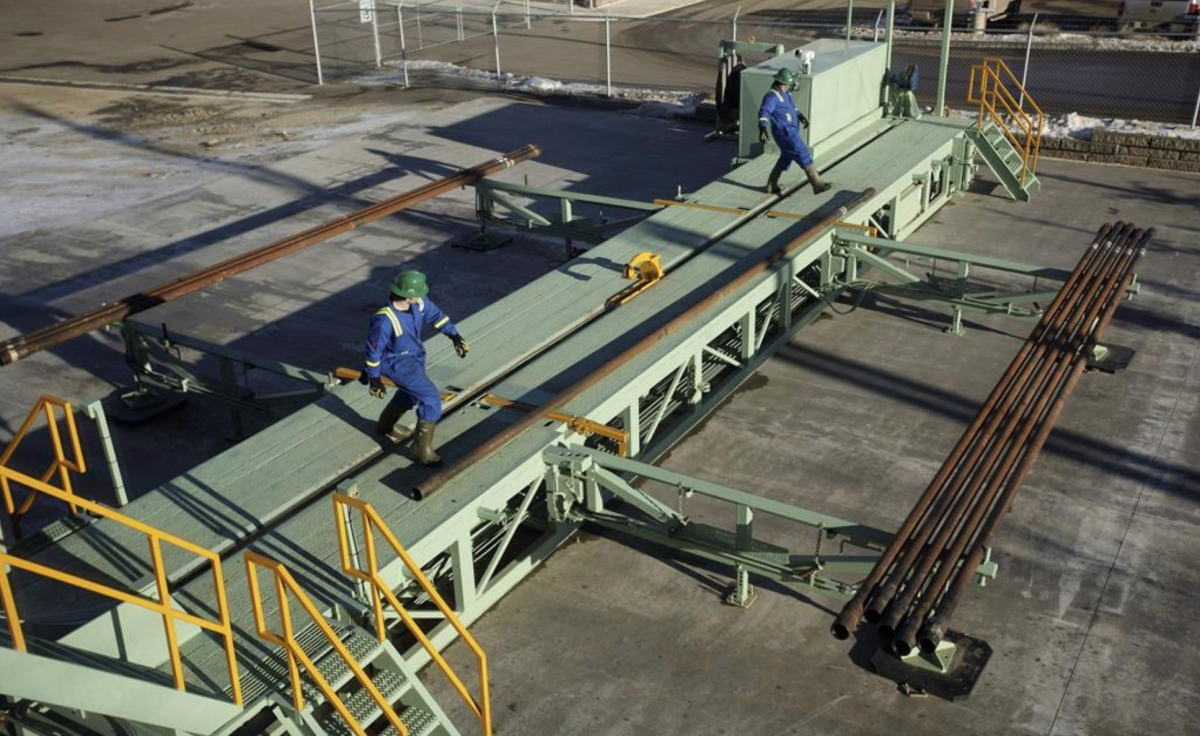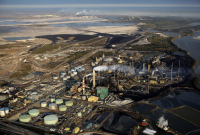Support strong Canadian climate journalism for 2025
Tens of thousands of oil and gas workers laid off during the downturn have been waiting for the patch to get back on its feet, but many of the jobs could be gone for good.
A rapid change in technology is playing out across the industry, after plummeting crude prices that began in 2015 forced companies to cut jobs and other costs wherever they could over the past two years.
Now, with oil holding steady above US$50 a barrel since December after having bottomed out to about $26 in early 2016, energy analysts say the growth of automation and other labour−saving efficiencies could hold back many jobs from returning with the economic recovery.
Take shale drilling, where just a few years ago you could find 30 rig hands operating diesel pumps, using headsets to synchronize the throttle and pressure needed to break apart the rock formations and free the trapped crude.
Today, that job can be done by two people sitting inside a control van, monitoring the automated, electrified systems, said Mark Salkeld, head of the Petroleum Services Association of Canada.
"Now on a drill rig you’ve got a driller sitting in a cyber chair, with dual joysticks, touch screens, everything instrumented. He can control the whole rig, he can see it all."
Companies are relying more on machine learning to crunch the bewildering array of data from the field, looking for ways to improve production and lower costs, said Warren Gieck, a production optimization leader at General Electric’s innovation centre in Calgary.
"As the market is settling out and people are looking at expanding, they’re looking at expanding their projects, but not the number of people that are running them," he said.
"They’re trying to do a lot more with a lot less," he noted. "The personnel that are left are just overloaded and need additional tools."
Gieck said that downturn has also accelerated the hunt for optimization because companies can’t afford to just drill extra wells like they could in the past.
The streamlined operations can be seen at Cenovus Energy (TSX:CVE), where the downturn spurred a major restructuring, says Drew Zieglgansberger, executive vice−president of oilsands manufacturing.
"We have been extremely focused over the last two years on efficiency and reducing our cost structures," he said by email.
The efforts have resulted in faster drilling, fewer well pads and other improvements that have cut non−fuel operating costs by 30 per cent.
Those efforts have also meant that despite cutting about a third of its head count in the downturn, Zieglgansberger says they won’t need to rehire anyone to go ahead with two expansion projects a year.
Companies like Cenovus and Suncor are moving increasingly to replicated plans, rather than starting from scratch, meaning design time for projects have plummeted.
Suncor says it has slashed the engineering time for a new steam−based oilsands well pad to 800 hours for its new design, compared with about 9,100 hours between 2010 and 2015.
And companies are looking to push advancements on the more mature mining method as well, with Suncor already operating a driverless truck pilot project at its oilsands mine. Shell and Imperial (TSX:IMO) have also said they’re looking into the potential of autonomous trucks.
Salkeld said smaller companies, like those on the service side, haven’t been able to invest as much in technology because of the downturn — but with the industry picking up, so too is the push for automation.
Precision Drilling (TSX:PD) boasted in its latest quarterly results that it will be working to further the automation on its Super Triple rigs, with mechanized pipe feeding and the ability to walk itself to the next pad, while also pushing for further "de−manned" directional drilling services.
Big rigs still require a lot of workers, noted Salkeld, with some of the largest creating an estimated 300 direct and indirect jobs, but those rigs are doing the work of what some five did before.
Looking ahead, Salkeld said he sees a continued push towards robotics with a crew of two or less, both for costs and increased safety. He said that future is already arriving, having recently seen a new type of automated rig online.
"It was a video of this massive, automotive assembly−line type, Star Wars−type robot, that was picking up the pipe, drilling it, and there wasn’t a person in sight."





Comments
So here we have it. Increased extractivism of the already over-resourced land base, run remotely with video cameras and 'joy' sticks....by one or two glorified operatives. High capital costs in the fossil fuel extractisim business already make "jobs' very expensive to create.......but in the future, 'jobs' won't be much of a justification for what the BIG BOYS FROM AWAY are going to continue to do to our land, our resources, and our watersheds.
Great News. We'll race toward the extinction cliff, on unemployment insurance, or welfare payments. Or maybe our young people can go abroad as foreign temporary workers.......or if they are very obsequious, and keep their noses clean, maybe they can climb the corporate ladder and make decisions about how to f... the land base of third world countries...........sending the loot home to mom and the 1.5 kids keeping the home fires burning in one of those Calgary mansions we keep building.
The future looks pretty de-humanized, in a pretty literal way. Unless of course we up the royalties these Grynne Morgan types have to pay........and pour all of the cash into jobs in renewables. I hear there might be a future there.
With Alberta's low royalties we're not getting much money flowing into provincial coffers. Now they're reducing the number of people employed. In the end Albertans get little but abandoned wells, contaminated air and soil, and a march toward the climate cliff. Even investors are fleeing the oil patch for fear of stranded assets. When are we going to transition to renewable energy?
Numerous experts have said that the tens of thousands of jobs that governments and industry are claiming will be added by the massive expansion and pipelines (Clarke claimed 100,000 jobs in BC LNG alone!) are complete nonsense. At best a few thousand temporary hires (cheap TFW) will be needed as much of the infrastructure is expected to arrive from overseas pre-assembled. Once finished, these Multinationals are allowed to cut back to skeletal staffing because they all claim to have "cutting edge" and "world leading" technology to instantly detect all issues or leaks. The Precautionary Principle has been replaced by the "What Could Go Wrong" rationale in every aspect of decision making. It turns out that everything can go wrong, regardless of the technology, and there are leaks, spills, accidents, negligence, broken rules, illegal activities, and more happening every single day - going unreported by industry, ignored or covered up by regulators and government. Increasing technology might make some aspects safer, but cutting staff on the ground is dangerous.